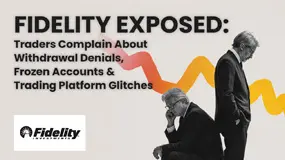简体中文
繁體中文
English
Pусский
日本語
ภาษาไทย
Tiếng Việt
Bahasa Indonesia
Español
हिन्दी
Filippiiniläinen
Français
Deutsch
Português
Türkçe
한국어
العربية
The Truth About Diversification: Why Most Traders Get It Wrong
Abstract:Diversification is often hailed as the holy grail of risk management, a strategy that every trader and investor should adopt to protect their portfolio. But the reality is that many traders misunderstand the concept, believing that simply holding multiple assets equates to lower risk. So, how can diversification be done the right way? Let’s uncover the common misconceptions and explore professional strategies to ensure risk is truly mitigated.

Diversification is often hailed as the holy grail of risk management, a strategy that every trader and investor should adopt to protect their portfolio. But the reality is that many traders misunderstand the concept, believing that simply holding multiple assets equates to lower risk. In truth, poor diversification can do more harm than good, leading to inefficiencies, unnecessary exposure, and a false sense of security. So, how can diversification be done the right way? Lets uncover the common misconceptions and explore professional strategies to ensure risk is truly mitigated.

One of the most common mistakes traders make is over-diversification—spreading capital across too many instruments without a clear strategy. While it might seem logical to hold a mix of forex pairs, stocks, commodities, and cryptocurrencies, blindly adding assets without understanding their correlations can dilute returns rather than reduce risk. If a traders portfolio is too broad, it becomes difficult to manage effectively, often resulting in exposure to multiple assets that react similarly to market conditions.
Another pitfall is false diversification, where traders believe they are reducing risk simply by holding different assets, but in reality, those assets are highly correlated. For instance, a portfolio consisting of EUR/USD, GBP/USD, and AUD/USD might appear diversified because it involves different currency pairs, but all three are majorly influenced by the strength of the US dollar. Similarly, holding multiple tech stocks may seem diversified, but if the sector experiences a downturn, all holdings could suffer simultaneously.
Lastly, many traders ignore liquidity and volatility when diversifying. Some assets may be difficult to exit in times of market stress, while others may have extreme price swings that amplify risk rather than mitigate it. Simply holding a variety of instruments does not guarantee stability if those instruments behave erratically under pressure.

To achieve effective diversification, traders must move beyond the simplistic notion of owning multiple assets and instead focus on strategic diversification. This means selecting instruments that have low or negative correlations, ensuring that when one asset declines, another remains stable or appreciates.
A professional approach involves sector and asset-class diversification. Instead of clustering investments within a single sector or currency group, traders should consider exposure across equities, fixed income, commodities, and forex markets, ensuring that their portfolio can withstand different economic cycles.
Another key element is timeframe diversification. Many traders focus solely on short-term trades, exposing themselves to immediate market fluctuations. By incorporating a mix of intraday, swing, and longer-term positions, they can hedge against unexpected volatility while capturing opportunities across different time horizons.
Risk-adjusted diversification is also crucial. Traders should allocate capital based on risk exposure rather than equally distributing funds across assets. For example, a 10% allocation to a highly volatile cryptocurrency does not carry the same risk as a 10% allocation to a stable government bond. Using risk-weighted position sizing ensures that higher-risk assets do not disproportionately impact the portfolio.
Diversification, when done correctly, is a powerful risk management tool; but when misunderstood, it can lead to unnecessary complexity and hidden risks. True diversification is not about owning more assets; it‘s about owning the right assets. By focusing on correlation, asset-class balance, timeframes, and risk-weighted allocation, traders can build a portfolio that is genuinely resilient rather than just broadly spread. In the ever-changing landscape of financial markets, understanding diversification the right way is not just a choice—it’s a necessity.

Disclaimer:
The views in this article only represent the author's personal views, and do not constitute investment advice on this platform. This platform does not guarantee the accuracy, completeness and timeliness of the information in the article, and will not be liable for any loss caused by the use of or reliance on the information in the article.
Read more

Fidelity Exposed: Traders Complain About Withdrawal Denials, Frozen Accounts & Platform Glitches
Does Fidelity Investments prevent you from accessing funds despite numerous assurances on your requests? Do you witness an account freeze by the US-based forex broker every time you request withdrawal access? Do you struggle with an unstable trading platform here? Is the slow Fidelity customer service making you face forced liquidation? These issues haunt traders, with many of them voicing their frustration on several broker review platforms such as WikiFX. In this Fidelity review article, we have shared quite a few complaints for you to look at. Read on!

Exposing The Trading Pit: Traders Blame the Broker for Unfair Withdrawal Denials & Account Blocks
Did you receive contradictory emails from The Trading Pit, with one approving payout and another rejecting it, citing trading rule violations? Did you purchase multiple trading accounts but receive a payout on only one of them? Did The Trading Pit prop firm refund you for the remaining accounts without clear reasoning? Did you face account bans despite using limited margins and keeping investment risks to a minimum? These are some raging complaints found under The Trading Pit review. We will share some of these complaints in this article. Take a look.

M&G Review: Traders Report Fund Scams, Misleading Market Info & False Return Promises
Applying for multiple withdrawals at M&G Investments but not getting it into your bank account? Do you see the uncredited withdrawal funds out of your forex trading account on the M&G login? Does the customer support service fail to address this trading issue? Does the misleading market information provided on this forex broker’s trading platform make you lose all your invested capital? Were you lured into investing under the promise of guaranteed forex returns? These issues have become highly common for traders at M&G Investments. In this M&G review article, we have echoed investor sentiments through their complaint screenshots. Take a look!

INZO Broker MT5 Review 2025: A Trader's Guide to Features, Fees and Risks
INZO is a foreign exchange (Forex) and Contracts for Difference (CFD) brokerage company that started working in 2021. The company is registered in Saint Vincent and the Grenadines and regulated offshore. It focuses on serving clients around the world by giving them access to popular trading platforms, especially MetaTrader 5 (MT5) and cTrader. The company offers different types of trading instruments, from currency pairs to cryptocurrencies. It aims to help both new and experienced traders. Read on to know more about it.
WikiFX Broker
Latest News
2 Malaysians Arrested in $1 Million Gold Scam Impersonating Singapore Officials
Is FXPesa Regulated? Real User Reviews & Regulation Check
Fraud Mastermind Zhimin Qian Sentenced to 11 Years for $6.6 Billion Bitcoin Ponzi Scheme
Almahfaza Broker – 2025 Review: Safe or Scam?
Uniglobe Markets Review 2025: A Complete Guide to an Unregulated Broker
INZO Broker No Deposit Bonus: A 2025 Deep Dive into Its Offers and Risks
Exness Broker Expands in South Africa with Cape Town Hub
Global Guide to Finding Forex IBs/Brokers — Share Your Pick and Win Big!
Trump tariffs are helping drive U.S. beef prices to new highs
BTSE Review: Ponzi Scam, KYC Verification Hassles & Account Blocks Hit Traders Hard
Currency Calculator



